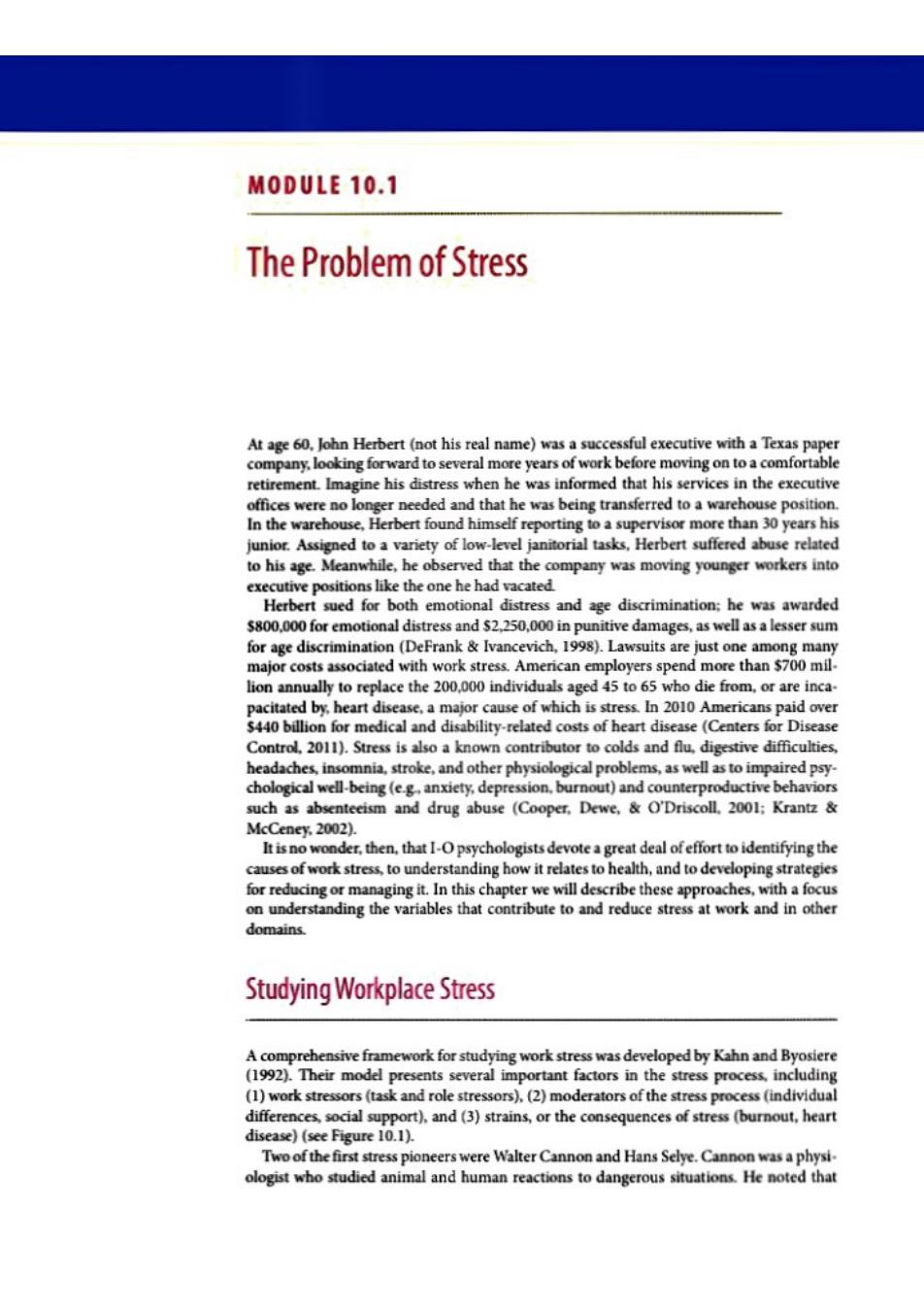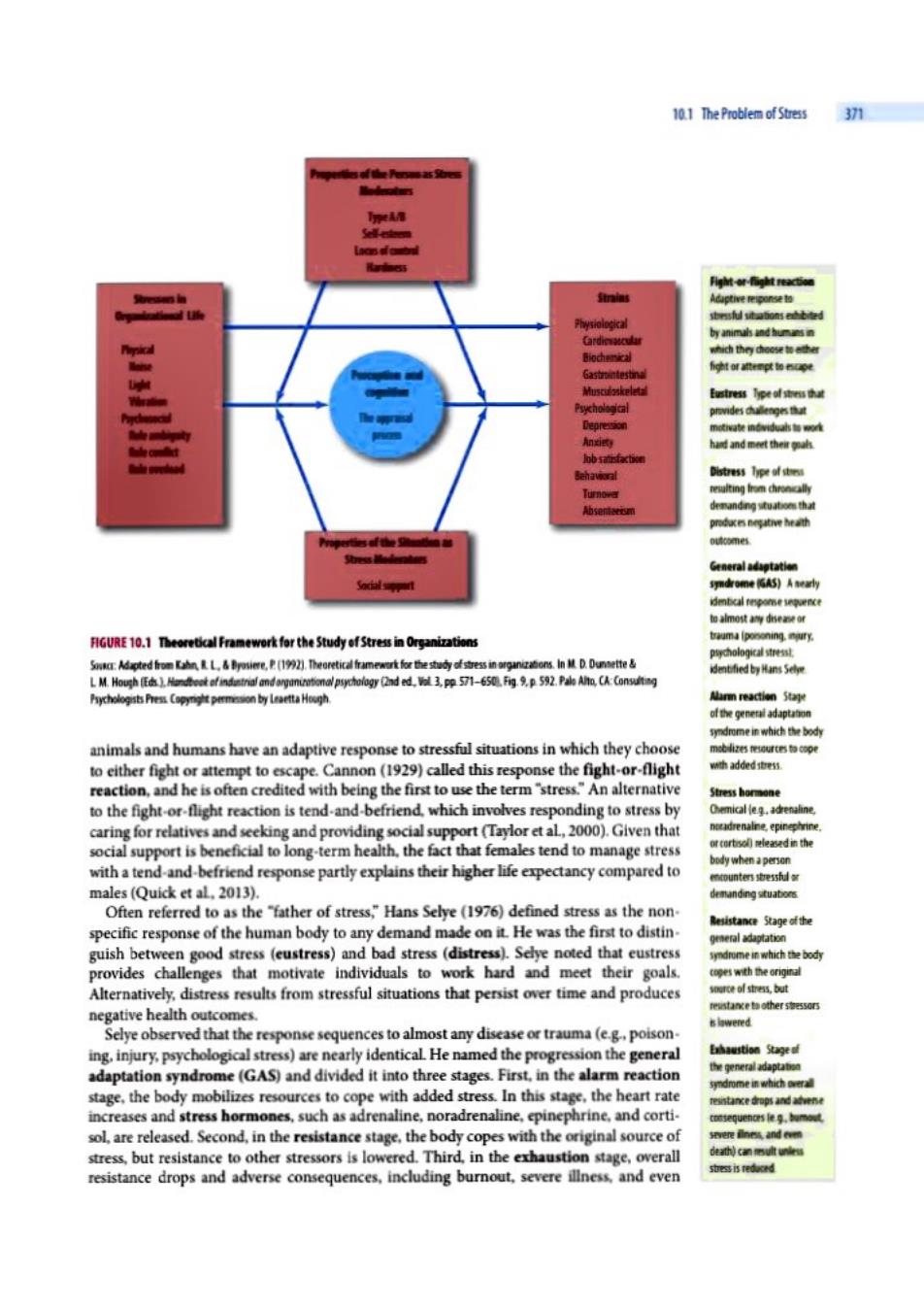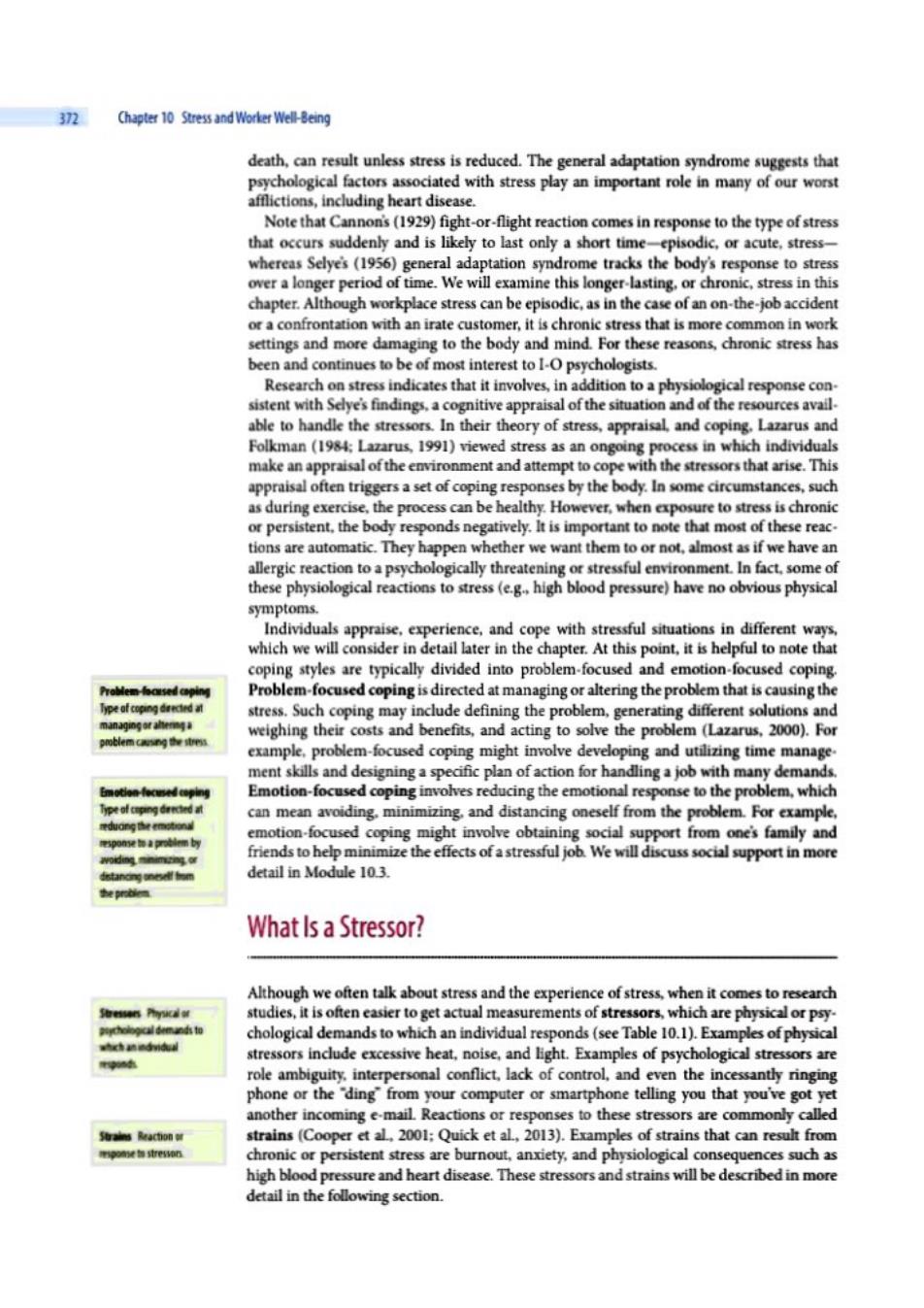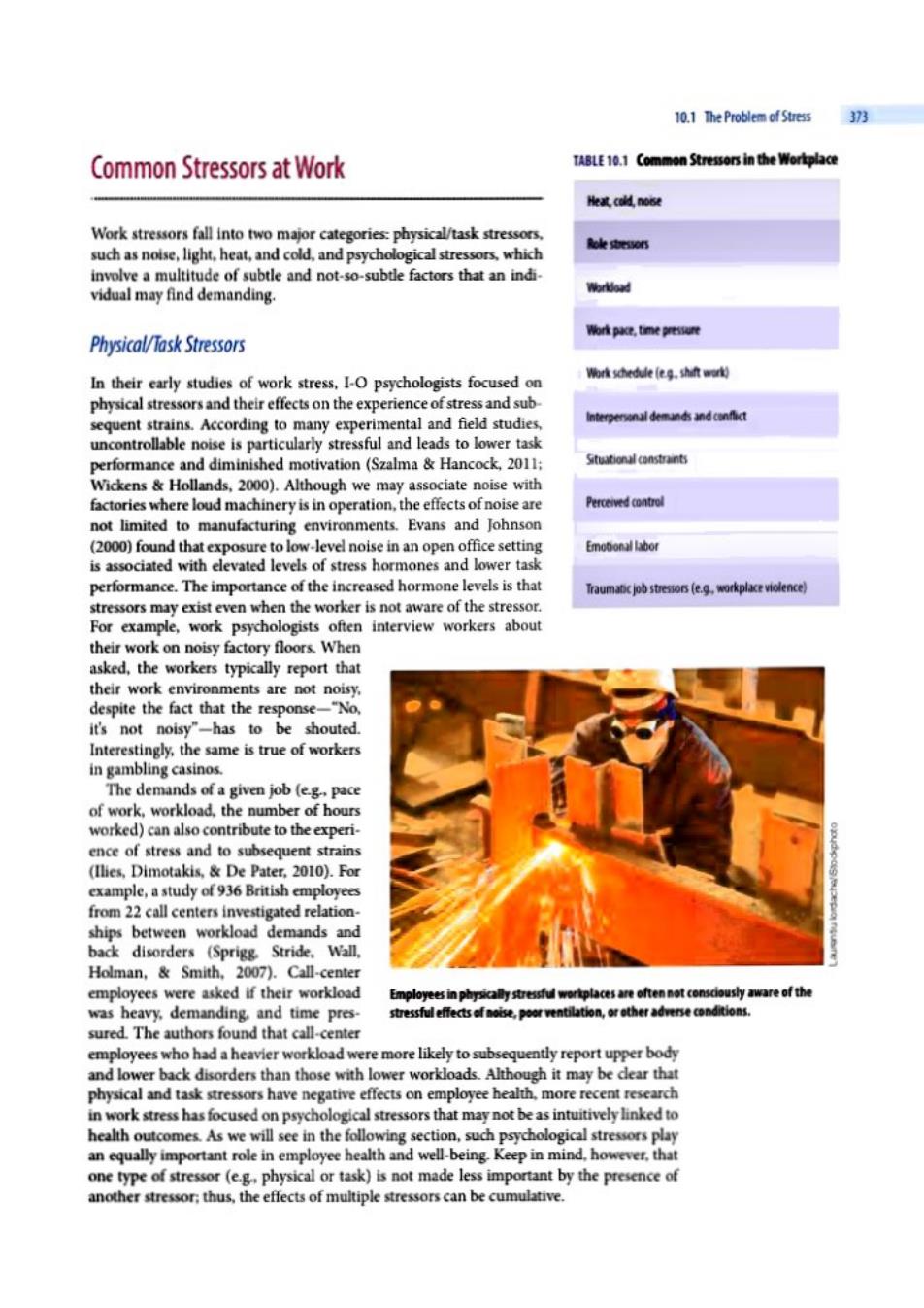
10 Stress and Worker Well-Being Module 10 1 The Problem of Stress 370 Tertiary Prevention Strategies 399 Studying Workplace Stress 370 Summary of Stress Intervention What Is a Stressor?372 Strategies 400 Common Stressors at Work 373 Module 104 Violence at Work 402 Consequences of Stress 378 Stress and Workplace Violence 402 Work Schedules 382 The"Typical'Violent Worker 403 Module 102 Theories of Stress 387 Theones of Workplace Violence 404 Demand-Control Model 387 A Specal Type ofViolence:Bullying 408 Person-Environment Fit Model 388 What Can We Condude about Workplace Individual Drfferencesn Resistance Violence?410 to Stress 389 Module 10.3 Reducing and Managing Stress 395 Primary Prevention Strategies 395 Secondary Prevention Strategies 397

MODULE 10.1 The Problem of Stress At age 60.John Herbert (not his real name)was a successful executive with a Texas paper company.looking forward to several more years of work before moving on to a comfortable retirement.Imagine his distress when he was informed that his services in the executive offices were no longer needed and that he was being transferred to a warehouse position. In the warehouse,Herbert found himself reporting to a supervisor more than 30 years his junior.Assigned to a variety of low-level janitorial tasks.Herbert suffered abuse related to his age.Meanwhile,he observed that the company was moving younger workers into executive positions like the one he had vacated Herbert sued for both emotional distress and age discrimination:he was awarded $800,000 for emotional distress and $2,250,000 in punitive damages,as well as a lesser sum for age discrimination(DeFrank Ivancevich,1998).Lawsuits are just one among many major costs associated with work stress.American employers spend more than $700 mil. lion annually to replace the 200,000 individuals aged 45 to 65 who die from,or are inca- pacitated by,heart disease.a major cause of which is stress.In 2010 Americans paid over $440 billion for medical and disability-related costs of heart disease(Centers for Disease Control,2011).Stress is also a known contributor to colds and flu,digestive difficulties, headaches,insomnia,stroke,and other physiological problems,as well as to impaired psy- chological well-being(e.g.anxiety,depression.burnout)and counterproductive behaviors such as absenteeism and drug abuse (Cooper,Dewe,O'Driscoll.2001;Krantz McCeney,2002). It is no wonder,then.that I-O psychologists devote a great deal of effort to identifying the causes of work stress,to understanding how it relates to health,and to developing strategies for reducing or managing it.In this chapter we will describe these approaches,with a focus on understanding the variables that contribute to and reduce stress at work and in other domains. Studying Workplace Stress A comprehensive framework for studying work stress was developed by Kahn and Byosiere (1992).Their model presents several important factors in the stress process.including (1)work stressors (task and role stressors).(2)moderators of the stress process (individual differences,social support),and (3)strains,or the consequences of stress (burnout,heart disease)(see Figure 10.1). Two of the first stress pioneers were Walter Cannon and Hans Selye.Cannon was a physi. ologist who studied animal and human reactions to dangerous situations.He noted that

10.1 The Problem of Stress 3万 hh的的daee每e中g 三 h中傅tempt to mcape Fustress lpeol shess that prvides challenges thut mtivate nid每g nx的 hand and meet their oa lob sarsfaction Distress Type of ss resiting frem chroncally d年anding stuatioes th produces negative heath outcomes. General adagtation mdrome65A转y dmbcal repome sepuence omo银m diseae or FGURE 10.1 Theoretical Framework for the Study of Stress in Organizations truma (ponening.nury. ppchological stpessl oc:Adacted from【u点LL&rusiere.(1992).eoretical frameweri for the奇ct女ess in organizaons.h慧D.Dunsette& identified与4nmSe LM.Hough()findtnal adarganuntonalpychology (nd ed.Vol 3.pp 571-650 Figp 592.Pale Alo CAConwng ychologists Press Capymght permmion by Leaetta Hough 山m体action5求 of the genenl adaptaton drome in which制bod animals and humans have an adaptive response to stressful situations in which they choose meblizes tesources与coe to either fight or attempt to escape.Cannon (1929)called this response the fight-or-flight wth added stess. reaction,and he is often credited with being the first to use the term'stress."An alternative Stress hormone to the fight-or-flight reaction is tend-and-befriend.which involves responding to stress by Chemical le.g.adrenaline caring for relatives and seeking and providing social support (Taylor et al,2000).Given that social support is beneficial to long-term health.the fact that females tend to manage stress 前crtso)leedin the body when a persen with a tend-and-befriend response partly explains their higher life expectancy compared to encounters stresstulor males(Quick et al,2013). demanding stuaboes Often referred to as the "father of stress,"Hans Selye (1976)defined stress as the non. Resistance Stage ofthe specific response of the human body to any demand made on it.He was the first to distin. gmneral ac山ptation guish between good stress (eustress)and bad stress(distress).Selye noted that eustress sdmme in which the boc寸 provides challenges that motivate individuals to work hard and meet their goals. cpes with the original Alternatively,distress results from stressful situations that persist over time and produces source of stress,but negative health outcomes. feKe与other stes5a5 sawered Selye observed that the response sequences to almost any disease or trauma (e.g.poison. ing.injury,psychological stress)are nearly identical He named the progression the general Ehaustion Stage of adaptation syndrome(GAS)and divided it into three stages.First.in the alarm reaction the general adaptaton sydrome in which overall stage,the body mobilizes resources to cope with added stress.In this stage,the heart rate et家edrups and advene increases and stress hormones,such as adrenaline,noradrenaline,epinephrine,and corti. csequenors fe.g.bumout sol,are released.Second,in the resistance stage,the body copes with the original source of severe iness and even stress,but resistance to other stressors is lowered.Third,in the exhaustion stage,overall t制c输w哺n相 sts书edad resistance drops and adverse consequences,including burnout,severe illness,and even

32 Chapter 10 Stress and Worker Well-Being death,can result unless stress is reduced.The general adaptation syndrome suggests that psychological factors associated with stress play an important role in many of our worst afflictions,including heart disease. Note that Cannon's (1929)fight-or-flight reaction comes in response to the type of stress that occurs suddenly and is likely to last only a short time-episodic,or acute,stress- whereas Selye's (1956)general adaptation syndrome tracks the body's response to stress over a longer period of time.We will examine this longer-lasting.or chronic,stress in this chapter.Although workplace stress can be episodic,as in the case of an on-the-job accident or a confrontation with an irate customer,it is chronic stress that is more common in work settings and more damaging to the body and mind.For these reasons,chronic stress has been and continues to be of most interest to I-O psychologists. Research on stress indicates that it involves,in addition to a physiological response con. sistent with Selye's findings.a cognitive appraisal of the situation and of the resources avail. able to handle the stressors.In their theory of stress,appraisal,and coping.Lazarus and Folkman(1984:Lazarus,1991)viewed stress as an ongoing process in which individuals make an appraisal ofthe environment and attempt to cope with the stressors that arise.This appraisal often triggers a set of coping responses by the body.In some circumstances,such as during exercise,the process can be healthy.However,when exposure to stress is chronic or persistent.the body responds negatively.It is important to note that most of these reac- tions are automatic.They happen whether we want them to or not,almost as if we have an allergic reaction to a psychologically threatening or stressful environment.In fact.some of these physiological reactions to stress(e.g..high blood pressure)have no obvious physical symptoms. Individuals appraise,experience,and cope with stressful situations in different ways. which we will consider in detail later in the chapter.At this point,it is helpful to note that coping styles are typically divided into problem-focused and emotion-focused coping. Problem-foorsed copin Problem-focused coping is directed at managing or altering the problem that is causing the lype af coping drectnd at stress.Such coping may include defining the problem,generating different solutions and weighing their costs and benefits,and acting to solve the problem (Lazarus,2000).For example.problem-focused coping might involve developing and utilizing time manage. ment skills and designing a specific plan of action for handling a job with many demands. Emotion-focused coping involves reducing the emotional response to the problem,which can mean avoiding.minimizing.and distancing oneself from the problem.For example, emotion-focused coping might involve obtaining social support from one's family and friends to help minimize the effects of a stressful job We will discuss social support in more detail in Module 10.3. What Is a Stressor? Although we often talk about stress and the experience of stress,when it comes to research studies,it is often easier to get actual measurements of stressors,which are physical or psy- chological demands to which an individual responds(see Table 10.1).Examples of physical stressors include excessive heat,noise,and light.Examples of psychological stressors are role ambiguity.interpersonal conflict,lack of control,and even the incessantly ringing phone or the 'ding"from your computer or smartphone telling you that you've got yet another incoming e-mail Reactions or responses to these stressors are commonly called strains (Cooper et al.2001;Quick et al,2013).Examples of strains that can result from chronic or persistent stress are burnout,anxiety,and physiological consequences such as high blood pressure and heart disease.These stressors and strains will be described in more detail in the following section

10.1 The Problem of Stress 373 Common Stressors at Work TABLE 10.1 Common Stressors in the Workplace k成cold.no6 Work stressors fall into two major categories:physical/task stressors. Role stessors such as noise,light,heat,and cold,and psychological stressors.which involve a multitude of subtle and not-so-subtle factors that an indi- vidual may find demanding. Woridoad 称hp笔,time pressur Physical/Task Stressors Nork schedule (e.g.hnae由 In their early studies of work stress,I-O psychologists focused on physical stressors and their effects on the experience of stress and sub sequent strains.According to many experimental and field studies, Interpernal demands and canfict uncontrollable noise is particularly stressful and leads to lower task performance and diminished motivation (Szalma Hancock,2011: Situational constraints Wickens Hollands,2000).Although we may associate noise with factories where loud machinery is in operation,the effects of noise are Perceivedcontrol not limited to manufacturing environments.Evans and Johnson (2000)found that exposure to low-level noise in an open office setting Emotional labor is associated with elevated levels of stress hormones and lower task performance.The importance of the increased hormone levels is that Traumatic job stressors (e.g workplaceviolence) stressors may exist even when the worker is not aware of the stressor. For example,work psychologists often interview workers about their work on noisy factory floors.When asked,the workers typically report that their work environments are not noisy. despite the fact that the response-"No. it's not noisy"-has to be shouted. Interestingly,the same is true of workers in gambling casinos. The demands of a given job (eg.pace of work,workload,the number of hours worked)can also contribute to the experi- ence of stress and to subsequent strains (Ilies,Dimotakis,De Pater.2010).For example,a study of 936 British employees from 22 call centers investigated relation- ships between workload demands and back disorders (Sprigg.Stride.Wall, Holman,Smith,2007).Call-center employees were asked if their workload Employees in physically stressful workplaces are often not conscously aware of the was heavy,demanding.and time pres. stressful effects of oise,poor ventilation,orther adverse conditions. sured.The authors found that call-center employees who had a heavier workload were more likely to subsequently report upper body and lower back disorders than those with lower workloads.Although it may be dear that physical and task stressors have negative effects on employee health.more recent research in work stress has focused on psychological stressors that may not be as intuitively linked to health outcomes.As we will see in the following section,such psychological stressors play an equally important role in employee health and well-being.Keep in mind,however,that one type of stressor(eg.physical or task)is not made less important by the presence of another stressor;thus,the effects of multiple stressors can be cumulative